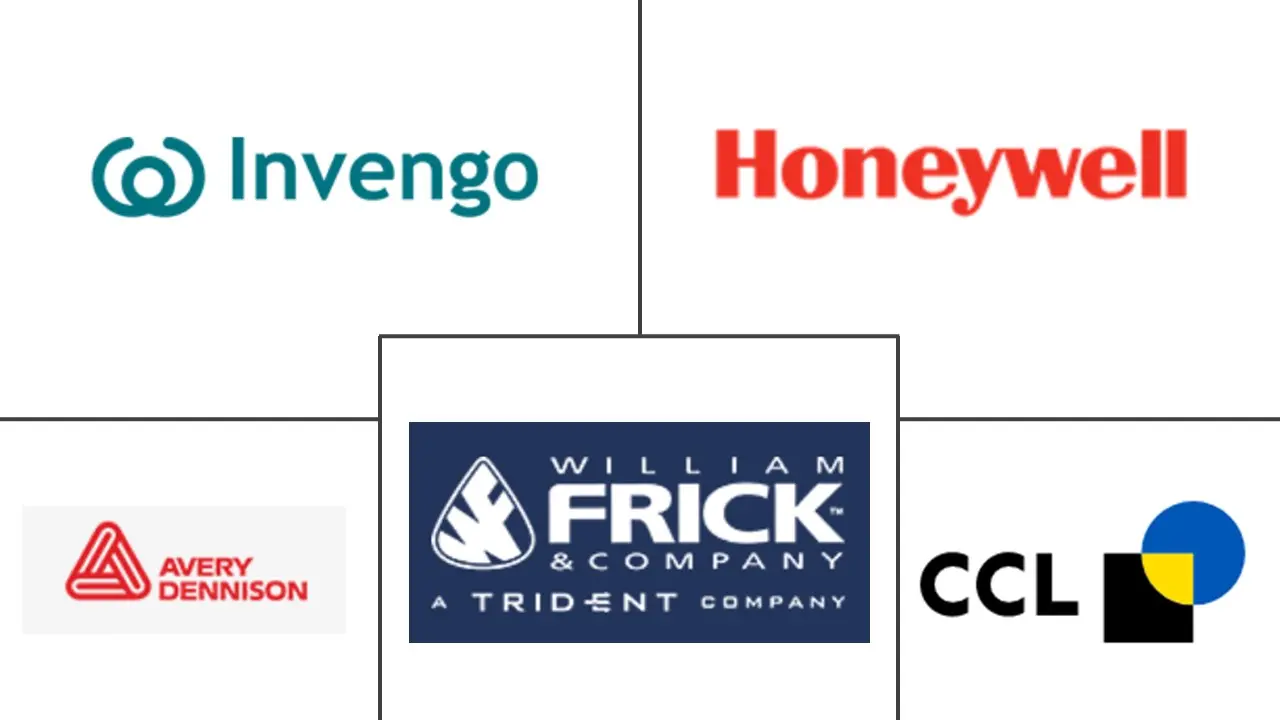Smart Label Market Size and Share
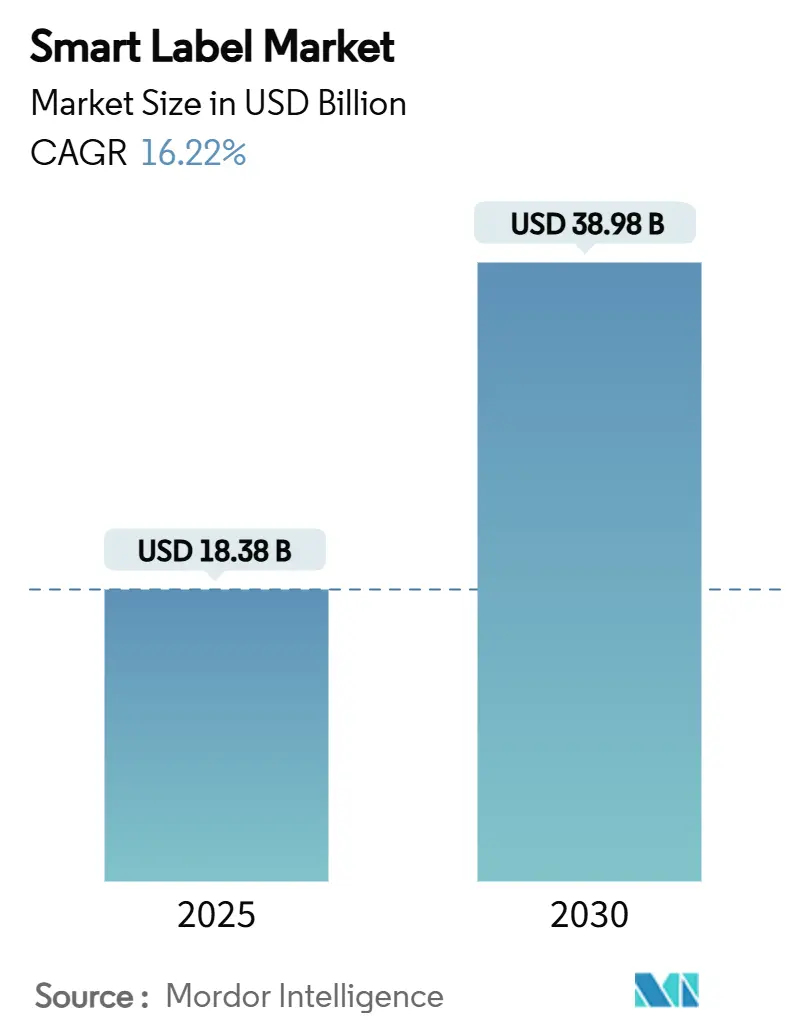
Smart Label Market Analysis by Mordor Intelligence
The smart label market size is valued at USD 18.38 billion in 2025 and is forecast to reach USD 38.98 billion by 2030, advancing at a 16.22% CAGR. This growth reflects the intersection of regulatory mandates, advances in radio-frequency identification (RFID) and near-field communication (NFC) technologies, and rising demand for end-to-end supply-chain transparency. Pharmaceutical serialization under the FDA’s Drug Supply Chain Security Act, the European Union’s Packaging and Packaging Waste Regulation (PPWR) that embeds digital‐product-passport concepts, and retailer-driven RFID programs such as Walmart’s have together created a non-negotiable compliance baseline. Companies are responding by integrating cloud analytics, blockchain authentication, and ambient IoT sensors that convert passive labels into data-rich assets, enabling real-time inventory visibility, dynamic pricing, and condition monitoring across industries.
Key Report Takeaways
- By technology, RFID held 38.32% of the smart label market share in 2024, while NFC is projected to grow at a 20.13% CAGR through 2030.
- By end-user industry, retail led with 31.03% revenue share in 2024; healthcare and pharmaceuticals are expected to expand at a 19.67% CAGR to 2030.
- By component, antennas and transceivers accounted for 27.32% of the smart label market size in 2024; sensors are forecast to register 19.43% CAGR through 2030.
- By application, asset and inventory tracking commanded 34.31% of the smart label market size in 2024, while cold-chain monitoring is advancing at an 18.92% CAGR.
- By label form factor, wet-inlay/sticker labels led with 42.64% revenue share in 2024; printable flexible sensor labels are poised for 19.56% CAGR through 2030.
- By geography, North America captured 37.84% of the smart label market share in 2024; Asia-Pacific shows the fastest growth trajectory at 18.73% CAGR to 2030.
Global Smart Label Market Trends and Insights
Drivers Impact Analysis
| Driver | ( ~ ) % Impact on CAGR Forecast | Geographic Relevance | Impact Timeline |
|---|---|---|---|
| Growing RFID adoption for inventory visibility | +3.2% | Global (North America & EU lead) | Medium term (2-4 years) |
| Anti-counterfeiting demand in pharma supply chains | +2.8% | Regulated markets worldwide | Short term (≤ 2 years) |
| Omnichannel retail expansion requiring real-time pricing | +2.5% | North America & EU, widening to APAC | Medium term (2-4 years) |
| IoT-enabled logistics penetration | +2.1% | Global (rapid APAC uptake) | Long term (≥ 4 years) |
| Printed battery-free sensor labels for cold-chain integrity | +1.8% | Global pharma corridors | Long term (≥ 4 years) |
| EU ESG packaging mandates (PPWR 2026) | +1.4% | Primarily EU | Short term (≤ 2 years) |
| Source: Mordor Intelligence | |||
Growing RFID Adoption for Inventory Visibility
Walmart’s mandate for ultra-high-frequency (UHF) RFID tags on thousands of stock-keeping units has pushed suppliers to retrofit production lines, catalyzing sector-wide investment in RAIN RFID encoding solutions. Suppliers gain perpetual stock visibility that feeds directly into manufacturing execution systems, reducing material shortages and unlocking digital-twin scheduling efficiencies. Qualcomm’s plan to embed RAIN RFID in smartphones will soon turn every consumer device into a reader, eliminating the need for fixed scanner infrastructure and accelerating small-retailer adoption. [1]Seritag, “How Will Adding RAIN RFID to Mobile Phones Impact the Market?” seritag.com Meanwhile, antenna miniaturization now supports 10-foot read ranges, enabling frictionless checkout zones that elevate customer experience.
Rising Demand for Anti-Counterfeiting in Pharma Supply Chains
Full enforcement of the DSCSA in November 2024 requires trading partners to verify serialized identifiers before product hand-off, prompting label upgrades that combine NFC chips, blockchain encryption, and e-paper displays for tamper evidence and dosage information. Ynvisible’s ConnectedLabel, for instance, supports near real-time temperature tracking on over 1 million pharma packs annually. Outside the United States, India has ordered QR codes on the top-selling medicines, illustrating how serialization is moving from compliance exercise to patient-safety differentiator.
Expansion of Omnichannel Retail Requiring Real-Time Pricing
Electronic shelf labels (ESLs) now allow price updates every 10 seconds, letting retailers align online and in-store pricing strategies instantaneously. Walmart’s USD 2.8 billion ESL rollout across 2,300 stores is delivering labor savings that compress ROI into as little as 18 months. [2]Slashdot, “Walmart Announces Electronic Shelf Labels They Can Change Remotely,” slashdot.org Independent grocers that have piloted ESLs report elimination of manual price audits and markdown errors, enhancing both shopper trust and gross-margin management. [3] IGA, “Electronic Shelf Labels Deliver Flexibility & Eliminate Pricing Errors,” iga.com
Increasing Penetration of IoT-Enabled Logistics
Ambient energy-harvesting tags such as Wiliot’s IoT Pixels transmit humidity and temperature data without batteries, solving sustainability and maintenance hurdles in multi-modal shipping. Multi-radio devices that combine NB-IoT and BLE mesh are driving continuous container tracking across ocean, rail, and last-mile networks. [4]MDPI, “Design and Development of a High-Accuracy IoT System for Real-Time Load and Space Monitoring in Shipping Containers,” mdpi.comCellular-enabled smart labels from AT&T provide single-pane-of-glass visibility for vaccine shipments, enabling exception-based management to cut spoilage.
Restraints Impact Analysis
| Restraint | ( ~ ) % Impact on CAGR Forecast | Geographic Relevance | Impact Timeline |
|---|---|---|---|
| High initial hardware and integration costs for small retailers | -2.1% | Global (higher in developing markets) | Medium term (2-4 years) |
| Lack of universal interoperability standards | -1.9% | Cross-border trade | Long term (≥ 4 years) |
| Semiconductor supply constraints delaying UHF RFID IC availability | -1.8% | Asia-Pacific production hubs | Short term (≤ 2 years) |
| Data-privacy rules limiting NFC engagement analytics | -1.2% | EU and North America | Medium term (2-4 years) |
| Source: Mordor Intelligence | |||
High Initial Hardware and Integration Costs for Small Retailers
ESLs cost USD 11–12 per tag, creating steep capital requirements when rolled out across thousands of SKUs. Smaller retailers must also budget for point-of-sale upgrades and staff training, delaying adoption despite labor-saving potential. Subscription models are emerging but remain nascent.
Semiconductor Supply Constraints Delaying UHF RFID IC Availability
Foundries prioritized advanced nodes for AI chips in 2024–2025, stretching lead times on 65 nm RFID ICs from weeks to months. Smart-label manufacturers have resorted to larger inventory buffers and NFC substitution to protect production schedules.
Segment Analysis
By Technology: RFID Dominance Faces NFC Disruption
RFID accounted for 38.32% of the smart label market share in 2024, underpinned by proven scalability in retail and logistics. NFC, though smaller today, is projected for 20.13% CAGR because it exploits the global ubiquity of smartphones for tap-to-verify experiences. The smart label market size tied to NFC therefore shows the steepest absolute dollar expansion, especially in luxury authentication where blockchain integration delivers tamper-evident provenance. Electronic article surveillance remains steady, whereas sensing labels gain momentum through cold-chain and environmental compliance use cases. Overall, technology migration is moving from passive identification toward multifunction sensors and engagement tools.
Greater consumer interactivity is being unlocked by STMicroelectronics’ ST25Connect program, enabling NFC tags in medical devices, wine, and cosmetics to deliver personalized content while capturing engagement analytics. Integrating low-cost sensors within inlays further blurs lines between tracking, condition monitoring, and customer communication, placing RFID and NFC on convergent innovation paths.
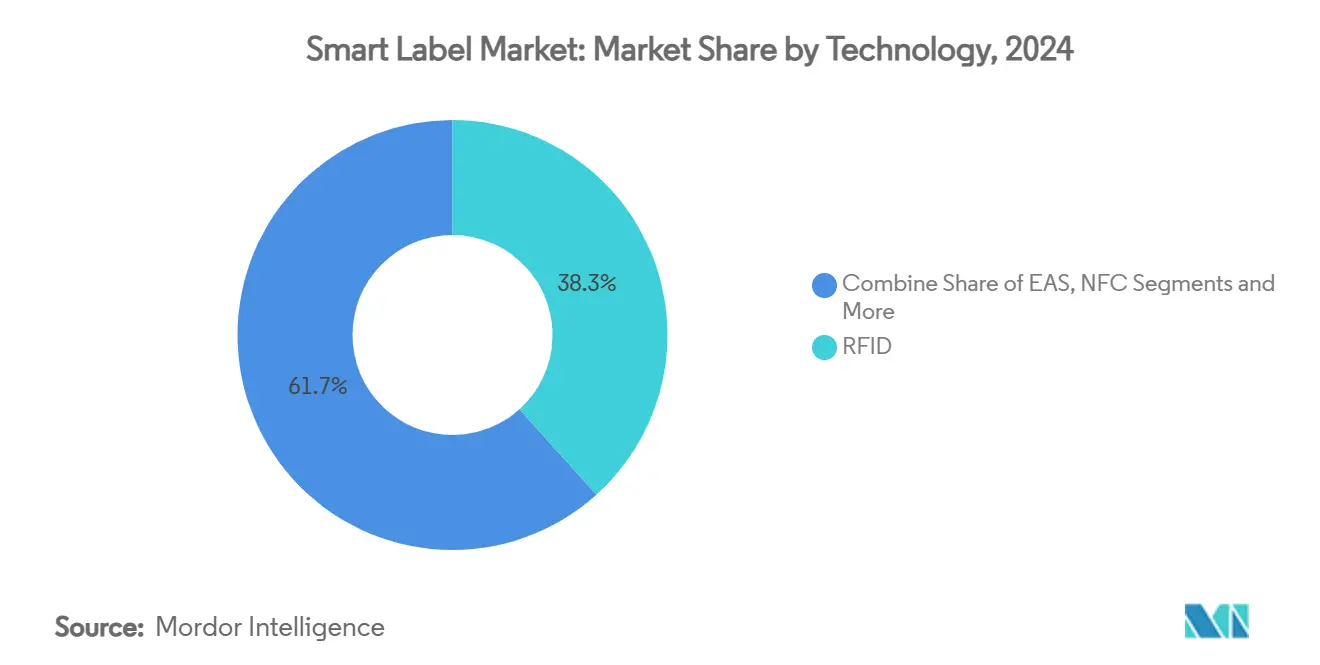
Note: Segment shares of all individual segments available upon report purchase
By End-User Industry: Healthcare Acceleration Challenges Retail Leadership
Retail retained 31.03% revenue share in 2024, reflecting early adoption of store-wide RFID programs and growing ESL footprints. However, the smart label market size linked to healthcare and pharmaceuticals is set to grow at 19.67% CAGR, the fastest across industries. Serialization deadlines and the need for temperature-controlled logistics drive hospitals, pharmacies, and contract manufacturers to embed smart labels for end-to-end traceability. Logistics providers and 3PLs also deploy hybrid cellular–BLE labels to automate hand-off documentation in real time.
Fresenius Kabi’s Data Matrix plus RFID initiative illustrates how medication verification cuts human error in high-acuity hospital environments. Digital display labels for clinical trials eliminate manual relabeling across language variants, improving patient compliance and simplifying regulatory audits. Similar dynamics extend to food and beverage players gearing up for the FDA’s FSMA 204 traceability mandates.
By Component: Sensor Growth Outpaces Traditional Hardware
Antennas and transceivers formed 27.32% of 2024 revenue, but sensors will register 19.43% CAGR as brands demand condition and freshness data. The shift aligns with ambient IoT advancements—battery-free devices that harvest radio-frequency energy, removing the logistical burden of replacing coin cells. Novel substrates hosting nanomaterials are enabling moisture and gas detection at label thickness, turning packages into self-diagnosing assets.
Software stacks are also rising in importance as SaaS dashboards convert RFID reads into geofenced event streams, driving value beyond the physical label. Platforms such as atma.io integrate billions of serialized items, delivering carbon-footprint insights and circular-economy reporting for brand owners.
By Application: Cold-Chain Monitoring Drives Growth Beyond Traditional Tracking
Asset and inventory tracking led with 34.31% revenue share in 2024, yet cold-chain monitoring is forecast for 18.92% CAGR to 2030 as shipment of biologics, vaccines, and perishable foods accelerates. Avery Dennison’s TT Sensor Plus 2 stores up to 100,000 temperature events and uploads data via NFC to cloud databases after delivery. Printed visual indicators such as DeltaTrak WarmMark support at-a-glance checks yet are increasingly paired with IoT sensors that push alerts before a breach becomes irrecoverable.
Dynamic pricing and promotion uses ESLs to align sell-through with shelf-life, while brand authentication applications use NFC/QR for anti-counterfeit defense. Work-in-process tracking in automotive and electronics plants integrates with digital-twin models, enabling automated replenishment and predictive maintenance.
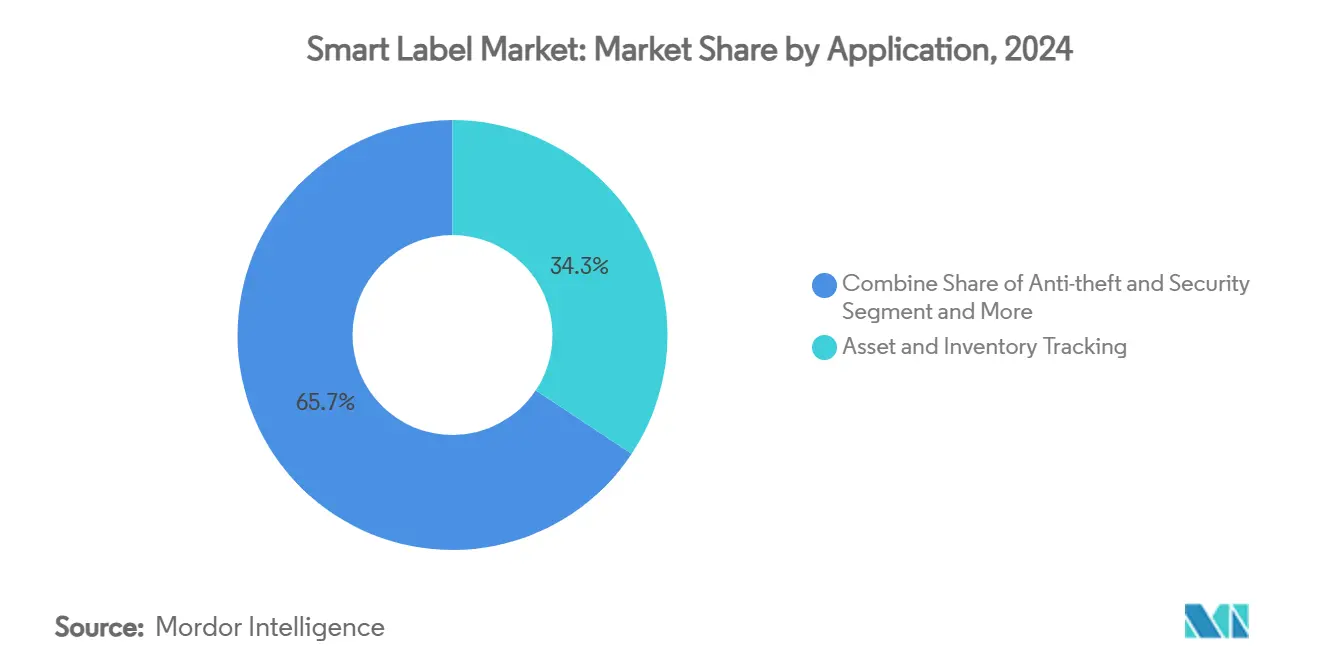
Note: Segment shares of all individual segments available upon report purchase
By Label Form Factor: Flexible Sensors Challenge Traditional Formats
Wet-inlay and sticker constructions still dominate with 42.64% revenue share in 2024, valued for print-and-apply simplicity and compatibility with legacy applicators. The printable flexible sensor labels category, the fastest-growing at 19.56% CAGR, answers sustainability and functionality questions in one step. These labels incorporate photovoltaic inks and ultra-low-power ICs to log temperature or humidity without adding bulk, meeting new-build IoT requirements notably in pharmaceuticals and fresh food.
Active Bluetooth shipping labels such as Reelables’ 4 × 8 inch format show how existing logistics workflows can incorporate real-time tracking without carton redesign. New designs for electric-vehicle battery traceability use metal-mount antennas engineered to withstand harsh automotive environments.
Geography Analysis
North America held 37.84% of global revenue in 2024, anchored by the United States’ early adoption of RFID in retail and the legally binding DSCSA serialization roadmap. Continued federal investment aimed at tripling domestic semiconductor output by 2030 will reduce chip shortages that have recently slowed deployment schedules. Canada and Mexico benefit from integrated cross-border commerce as near-shoring picks up, while Avery Dennison’s USD 100 million Querétaro facility is set to meet rising regional demand for smart labels.
Europe represents the second-largest regional block, buoyed by sustainability-centric regulation. The forthcoming PPWR mandates digital identifiers for recyclability scoring, and Germany’s battery-passport pilot for electric vehicles solidifies RFID within automotive value chains. Konica Minolta forecasts the European RFID label market to reach EUR 2.5 billion (USD 2.8 billion) by 2027, reflecting widespread adoption in consumer goods, healthcare, and industrial sectors.
Asia-Pacific is the fastest-growing geography with an 18.73% CAGR through 2030. China’s 2D-barcode rollout across 7,000 food producers, India’s QR-code traceability for plastic waste, and Japan’s industry-5.0 incentives together generate outsized momentum. Growing 5G and planned 6G coverage provides the network backbone for ambient IoT, supporting large-volume adoption of battery-free sensors. Chip manufacturing concentration in Taiwan and South Korea offers supply advantages, although geopolitical risk remains a variable.
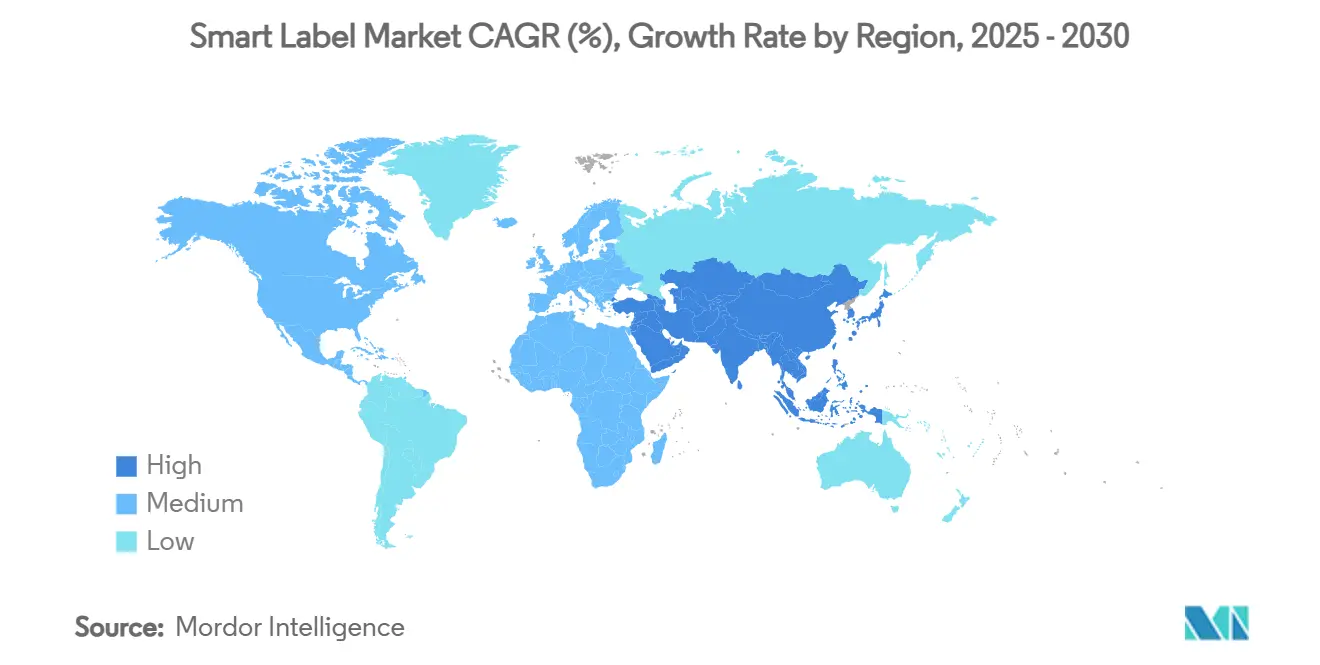
Competitive Landscape
The smart label market remains moderately fragmented. Incumbents like Avery Dennison, CCL Industries, and Zebra Technologies leverage multi-continent manufacturing footprints and vertically integrated materials to defend share. Capacity expansions—such as Avery Dennison’s Querétaro plant—signal a race to localize production, shorten lead times, and comply with regional content rules. The atma.io cloud platform now manages more than 30 billion items, illustrating how software ecosystems enhance stickiness.
M&A momentum is rising as scale becomes critical. Multi-Color Corporation’s purchase of Starport Technologies and ProMach’s Etiflex acquisition extend RFID competencies deeper into Latin America and consumer packaged goods. Mojix’s merger with Seagull Software combines hardware-agnostic labeling with a traceability data lake, enabling farm-to-fork or batch-to-patient transparency.
Innovation-driven entrants focus on specialized gaps. Sensos raised USD 20 million to commercialize cellular smart labels that eliminate handheld scanners for pallet-level tracking. Wiliot’s energy-harvesting pixels pivot the conversation to sustainability by removing battery waste entirely. Component makers such as Linxens are partnering with photovoltaic-ink specialists to produce fully battery-free sensor labels, lowering the total cost of ownership and expanding addressable applications.
Smart Label Industry Leaders
-
Avery Dennison Corporation
-
CCL Industries Inc.
-
William Frick & Company
-
Honeywell International Inc.
-
Invengo Information Technology Co. Ltd
- *Disclaimer: Major Players sorted in no particular order
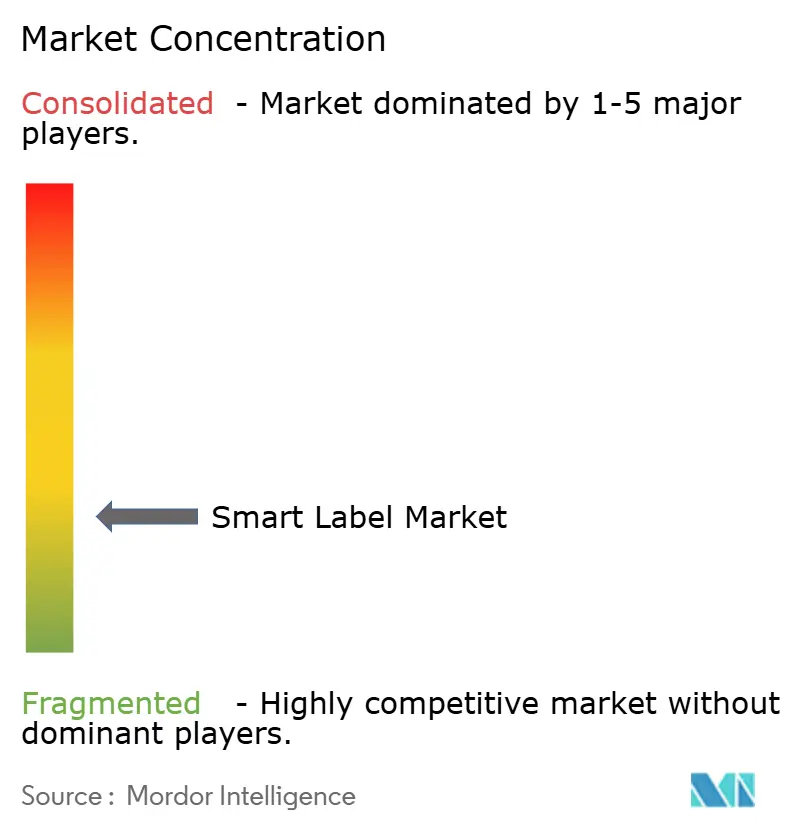
Recent Industry Developments
- March 2025: ProMach’s ID Technology acquired Etiflex, adding pressure-sensitive and RFID label production capacity in Mexico to serve growing North American demand.
- January 2025: Avery Dennison unveiled Optica solutions at NRF 2025, showcasing SKU-level traceability integrated with frictionless checkout for partners including JD Sports.
- December 2024: Wiliot launched Version 2.0 of its battery-free IoT Pixels, targeting food waste and medication-adherence monitoring.
- October 2024: Avery Dennison opened its USD 100 million RFID facility in Querétaro, Mexico, designed for LEED certification.
Global Smart Label Market Report Scope
The smart label market defines the revenues generated from technology such as electronic article surveillance (EAS), RFID, sensing labels, NFC, and electronic shelf labels (ESL) that are being used in various end-user industries globally. The study includes qualitative coverage of the most adopted strategies and an analysis of the key base indicators in emerging markets.
The smart label market is segmented by technology (electronic article surveillance [EAS], RFID, sensing labels, NFC, and electronic shelf labels [ESL]), end-user industry (retail, healthcare, pharmaceutical, logistics, and manufacturing), and geography (North America [United States and Canada], Europe [United Kingdom, Germany, France, and Rest of Europe], Asia-Pacific [China, India, Japan, South Korea, and Rest of Asia-Pacific], Latin America, and the Middle East, and Africa). The market sizes and forecasts are provided in terms of value in USD for all the segments.
| RFID |
| Electronic Article Surveillance (EAS) |
| Near Field Communication (NFC) |
| Sensing Labels (Temp, Gas, etc.) |
| Electronic Shelf Label (ESL) |
| Other Emerging (QR, BLE) |
| Retail |
| Healthcare and Pharmaceuticals |
| Logistics and Transportation |
| Manufacturing and Industrial |
| Food and Beverage |
| Other End-user Industry |
| Micro-controllers / ICs |
| Batteries and Power Units |
| Antennas and Transceivers |
| Sensors |
| Software and Middleware |
| Substrate and Protective Materials |
| Asset and Inventory Tracking |
| Anti-theft and Security |
| Cold-chain Monitoring |
| Dynamic Pricing and Promotion |
| Brand Authentication and Consumer Engagement |
| Work-in-Process Management |
| Wet-inlay / Sticker Labels |
| Hang Tags |
| In-mold Labels |
| Textile and Apparel Labels |
| Printable Flexible Sensor Labels |
| North America | United States | |
| Canada | ||
| Mexico | ||
| Europe | Germany | |
| United Kingdom | ||
| France | ||
| Italy | ||
| Spain | ||
| Russia | ||
| Rest of Europe | ||
| Asia-Pacific | China | |
| India | ||
| Japan | ||
| South Korea | ||
| Australia and New Zealand | ||
| Rest of Asia-Pacific | ||
| Middle East and Africa | Middle East | United Arab Emirates |
| Saudi Arabia | ||
| Turkey | ||
| Rest of Middle East | ||
| Africa | South Africa | |
| Nigeria | ||
| Egypt | ||
| Rest of Africa | ||
| South America | Brazil | |
| Argentina | ||
| Rest of South America | ||
| By Technology | RFID | ||
| Electronic Article Surveillance (EAS) | |||
| Near Field Communication (NFC) | |||
| Sensing Labels (Temp, Gas, etc.) | |||
| Electronic Shelf Label (ESL) | |||
| Other Emerging (QR, BLE) | |||
| By End-user Industry | Retail | ||
| Healthcare and Pharmaceuticals | |||
| Logistics and Transportation | |||
| Manufacturing and Industrial | |||
| Food and Beverage | |||
| Other End-user Industry | |||
| By Component | Micro-controllers / ICs | ||
| Batteries and Power Units | |||
| Antennas and Transceivers | |||
| Sensors | |||
| Software and Middleware | |||
| Substrate and Protective Materials | |||
| By Application | Asset and Inventory Tracking | ||
| Anti-theft and Security | |||
| Cold-chain Monitoring | |||
| Dynamic Pricing and Promotion | |||
| Brand Authentication and Consumer Engagement | |||
| Work-in-Process Management | |||
| By Label Form Factor | Wet-inlay / Sticker Labels | ||
| Hang Tags | |||
| In-mold Labels | |||
| Textile and Apparel Labels | |||
| Printable Flexible Sensor Labels | |||
| By Geography | North America | United States | |
| Canada | |||
| Mexico | |||
| Europe | Germany | ||
| United Kingdom | |||
| France | |||
| Italy | |||
| Spain | |||
| Russia | |||
| Rest of Europe | |||
| Asia-Pacific | China | ||
| India | |||
| Japan | |||
| South Korea | |||
| Australia and New Zealand | |||
| Rest of Asia-Pacific | |||
| Middle East and Africa | Middle East | United Arab Emirates | |
| Saudi Arabia | |||
| Turkey | |||
| Rest of Middle East | |||
| Africa | South Africa | ||
| Nigeria | |||
| Egypt | |||
| Rest of Africa | |||
| South America | Brazil | ||
| Argentina | |||
| Rest of South America | |||
Key Questions Answered in the Report
What is the projected size of the smart label market by 2030?
The smart label market size is expected to reach USD 38.98 billion by 2030, growing at a 16.22% CAGR.
Which technology segment is growing fastest within the smart label market?
Near-field communication smart labels are forecast to expand at a 20.13% CAGR, reflecting rising use in consumer engagement and anti-counterfeiting.
Why are healthcare and pharmaceutical companies rapidly adopting smart labels?
Regulatory serialization deadlines, patient-safety imperatives, and cold-chain integrity needs drive a 19.67% CAGR for smart-label deployments in healthcare.
How do electronic shelf labels support omnichannel retail?
ESLs enable real-time price changes across online and in-store channels, reducing labor and synchronizing promotions every few seconds.
What restrains wider adoption of smart labels among small retailers?
Up-front hardware costs of USD 11–12 per tag and integration expenses limit smaller retailers despite attractive return-on-investment timeframes.
Which region will deliver the fastest growth in smart label demand through 2030?
Asia-Pacific is projected for an 18.73% CAGR, fueled by large-scale barcode and QR initiatives in China and India, plus expanding 5G infrastructure.
Page last updated on:
